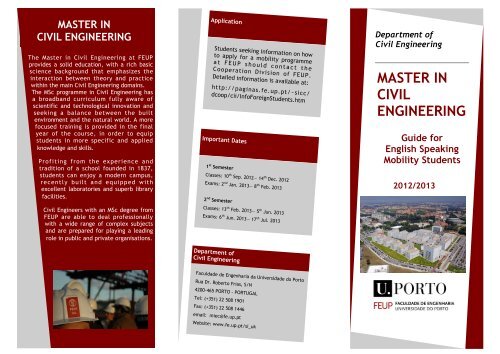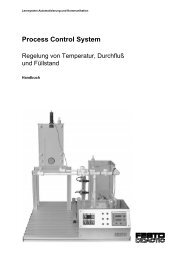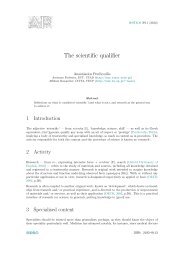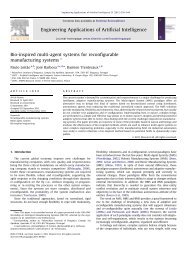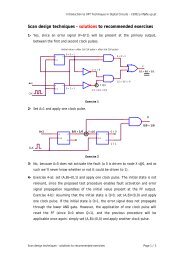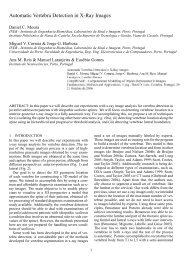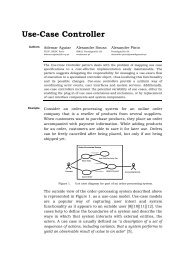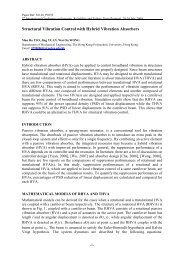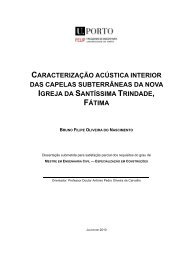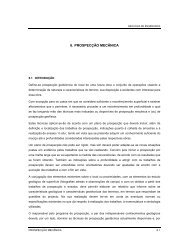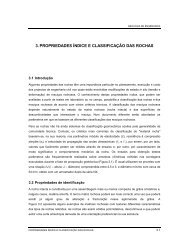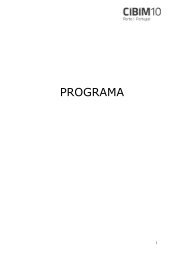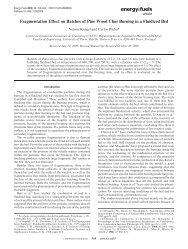MASTER IN CIVIL ENGINEERING - Faculdade de Engenharia da ...
MASTER IN CIVIL ENGINEERING - Faculdade de Engenharia da ...
MASTER IN CIVIL ENGINEERING - Faculdade de Engenharia da ...
Create successful ePaper yourself
Turn your PDF publications into a flip-book with our unique Google optimized e-Paper software.
<strong>MASTER</strong> <strong>IN</strong><br />
<strong>CIVIL</strong> ENG<strong>IN</strong>EER<strong>IN</strong>G<br />
The Master in Civil Engineering at FEUP<br />
provi<strong>de</strong>s a solid education, with a rich basic<br />
science background that emphasizes the<br />
interaction between theory and practice<br />
within the main Civil Engineering domains.<br />
The MSc programme in Civil Engineering has<br />
a broadband curriculum fully aware of<br />
scientific and technological innovation and<br />
seeking a balance between the built<br />
environment and the natural world. A more<br />
focused training is provi<strong>de</strong>d in the final<br />
year of the course, in or<strong>de</strong>r to equip<br />
stu<strong>de</strong>nts in more specific and applied<br />
knowledge and skills.<br />
Profiting from the experience and<br />
tradition of a school foun<strong>de</strong>d in 1837,<br />
stu<strong>de</strong>nts can enjoy a mo<strong>de</strong>rn campus,<br />
recently built a nd e quipped with<br />
excellent laboratories and superb library<br />
facilities.<br />
Civil Engineers with an MSc <strong>de</strong>gree from<br />
FEUP are able to <strong>de</strong>al professionally<br />
with a wi<strong>de</strong> range of complex subjects<br />
and are prepared for playing a leading<br />
role in public and private organisations.<br />
Application<br />
Stu<strong>de</strong>nts seeking information on how<br />
to apply for a mobility programme<br />
a t F E U P s h o u l d c o n t a c t t h e<br />
Cooperation Division of FEUP.<br />
Detailed information is available at:<br />
http://paginas.fe.up.pt/~sicc/<br />
dcoop/cii/InfoForeignStu<strong>de</strong>nts.htm<br />
Important Dates<br />
1 st Semester<br />
Classes: 10 th Sep. 2012— 14 th Dec. 2012<br />
Exams: 2 nd Jan. 2013— 8 th Feb. 2013<br />
2 nd Semester<br />
Classes: 13 th Feb. 2013— 5 th Jun. 2013<br />
Exams: 6 th Jun. 2013— 17 th Jul. 2013<br />
Department of<br />
Civil Engineering<br />
<strong>Facul<strong>da</strong><strong>de</strong></strong> <strong>de</strong> <strong>Engenharia</strong> <strong>da</strong> Universi<strong>da</strong><strong>de</strong> do Porto<br />
Rua Dr. Roberto Frias, S/N<br />
4200-465 PORTO - PORTUGAL<br />
Tel: (+351) 22 508 1901<br />
Fax: (+351) 22 508 1446<br />
email: miec@fe.up.pt<br />
Website: www.fe.up.pt/si_uk<br />
Department of<br />
Civil Engineering<br />
<strong>MASTER</strong> <strong>IN</strong><br />
<strong>CIVIL</strong><br />
ENG<strong>IN</strong>EER<strong>IN</strong>G<br />
Gui<strong>de</strong> for<br />
English Speaking<br />
Mobility Stu<strong>de</strong>nts<br />
2012/2013
MOBILITY STUDENTS<br />
International stu<strong>de</strong>nts looking for a mobility<br />
<strong>de</strong>stination will find that our Master in Civil<br />
Engineering offers i<strong>de</strong>al conditions for an<br />
unforgettable lifetime experience. With an<br />
attractive selection of 24 Course Units with<br />
classes in English, highly qualified teaching<br />
staff, experienced administrative personnel<br />
a n d w e l l e q u i p p e d c l a s s r o o m s a n d<br />
laboratories, the Master in Civil Engineering<br />
offers an education of excellence for<br />
mobility stu<strong>de</strong>nts.<br />
Herein are listed the course units with<br />
lectures and tutorial classes selected for<br />
mobility stu<strong>de</strong>nts without proficiency in<br />
Portuguese.<br />
Mobility stu<strong>de</strong>nts are also offered the<br />
possibility to complete their study with<br />
an MSc thesis supervised by a member of<br />
the teaching staff.<br />
<strong>MASTER</strong> <strong>IN</strong> <strong>CIVIL</strong> ENG<strong>IN</strong>EER<strong>IN</strong>G<br />
2012/2013<br />
ENGLISH LANGUAGE COURSE UNITS<br />
1 st SEMESTER ECTS<br />
Structural Analysis I 7.0<br />
Soil Mechanics I 7.0<br />
Roads I 5.5<br />
Structural Concrete I 8.0<br />
Environmental and Urban Hydraulics 6.5<br />
Construction Monitoring and Observation 5.0<br />
Construction with New Materials 5.0<br />
Steel and Composite Structures 5.0<br />
Earth Retaining Structures 5.0<br />
Un<strong>de</strong>rground Works 5.0<br />
Quality in Construction 5.0<br />
Planning and Environmental Quality 5.0<br />
Transport Systems 5.0<br />
Railways 5.0<br />
Maritime Works 1 5.0<br />
Maritime Works 2 5.0<br />
2 nd SEMESTER ECTS<br />
Structural Analysis II 7.0<br />
Soil Mechanics II 6.0<br />
Roads II 6.5<br />
Structural Concrete II 8.0<br />
Hydrology and Water Resources 6.5<br />
Technology of Construction 5.5<br />
Urban Environment and Transport Planning 5.0<br />
MSc Thesis 30.0<br />
THE CITY<br />
Classified as UNESCO World Heritage, Porto is<br />
the second city of the country and home to the<br />
largest Portuguese university. Besi<strong>de</strong>s its<br />
welcoming and historical environment, Porto is<br />
also contemporary and artistic. This is shown<br />
no t o n l y i n t h e s t r e et s , a r c hitectur e ,<br />
monuments and museums but also in the<br />
terraces, restaurants and leisure and shopping<br />
areas.<br />
TRAVEL AND ACCOMMODATION<br />
The Francisco Sá Carneiro International Airport<br />
offers regular and low-cost connections to all<br />
countries in Europe and to major airports<br />
worldwi<strong>de</strong>.<br />
Our administrative personnel will help incoming<br />
stu<strong>de</strong>nts to find accommo<strong>da</strong>tion for their stay in<br />
Porto. University’s guesthouses and wi<strong>de</strong>spread<br />
availability of private rooms keep living costs<br />
within every stu<strong>de</strong>nt’s reach.
Master in Civil Engineering<br />
List of Unit Courses<br />
For<br />
English Speaking Stu<strong>de</strong>nts<br />
Master in Civil Enginerring Page 1
FIRST SEMESTER<br />
Master in Civil Enginerring Page 2
Structural Analysis I<br />
Credits Contact Time Total Time<br />
7 ECTS 75 188<br />
Objectives, Skills and Learning Outcomes<br />
To study the principles of behavior of reticulate structures and <strong>de</strong>velopment of force<br />
and displacement method to calculate it.<br />
To expand the knowledge of hyperstatical structures behavior in linear regime.<br />
Program<br />
Chapter 1 – Introduction<br />
Objectives of Structural Analysis.<br />
The structural problem.<br />
Presentation and discussion of structural solutions.<br />
General hypothesis of the structure analysis.<br />
Structural types.<br />
External <strong>de</strong>mands/ solicitations.<br />
Displacements, distortions and tensions.<br />
Relations between tensions <strong>de</strong>formations.<br />
Equilibrium relations.<br />
Superposition-of-effects principle<br />
General aspects of the strength method.<br />
Chapter 2 – Displacement calculation<br />
Theorem of virtual work<br />
Calculation of the distortion internal work<br />
Displacements calculation using the theorem of virtual work<br />
Example of the displacement calculation using the theorem of virtual work<br />
“Bonfim Barreiros Method”<br />
Chapter 3 – Force method<br />
Structural hiperestaticity <strong>de</strong>gree. Internal and external hiperestaticity.<br />
Presentation and systematization of the force method.<br />
Final efforts in hyperstatic structures.<br />
Calculation of displacements in hyperstatic structures using the theorem of virtual<br />
work.<br />
Structures subject to the settlement of support and elastic support.<br />
Relative importance of the bending part due to transversal moments and efforts.<br />
Effect of temperature variations in structures.<br />
Uniform and differential variations.<br />
Evaluation of the hyperestaticity by direct inspection and a number of equilibrium<br />
equations.<br />
Mixed structures.<br />
Master in Civil Enginerring Page 3
Symmetrical structures with symmetrical and anti-symmetrical action. Symmetrical<br />
structures with any charge. Decomposition of a charge in a symmetrical and antisymmetrical<br />
part.<br />
Chapter 4 – Energy Theorems<br />
Introduction to Energy Theorems<br />
Distortion energy and virtual work.<br />
Distortion energy due to a charge system. Deduction of the theorem of virtual work.<br />
Deduction of the theorem of Betti. Maxwell’s reciprocal theorem (1st and 2nd<br />
consequences of the theorem of Betti).<br />
Deduction of the theorem of Castigliano and its inverse. Physical interpretation of the<br />
theorem and its application to the structure analysis.<br />
Third consequence of the Theorem of Betti. Determination of displacements in<br />
hiperestatical structures using the theorem of Castigliano.<br />
Chapter 5 – Influence lines<br />
Notion of influence line.<br />
Determination of influence lines of reactions of support in isostatic structures.<br />
Determination of influence lines of transversal efforts and bending moments in<br />
isostatic structures.<br />
Determination of efforts in structures by influence lines<br />
Influence lines in hyperstatic structures.<br />
Chapter 6 – Displacement Method<br />
The displacement method as strength method’s dual method. Illustration by a simple<br />
example.<br />
Direct formulation of the displacement method in the structure analysis.<br />
Obtaining of configurations correspon<strong>de</strong>nt to null and unit displacement. Obtaining of<br />
an equation system. Determination of the final efforts.<br />
Notion of stiffness matrix of a beam<br />
Discussion of the minimum number of unknowns to consi<strong>de</strong>r in the base system set<br />
up.<br />
Application of the displacement method in the case of structures with beams with<br />
<strong>de</strong>spicable axial <strong>de</strong>formability. Use of the principal of virtual work to <strong>de</strong>termine the<br />
fixation forces in structures with beams with <strong>de</strong>spicable axial <strong>de</strong>formation<br />
Determination of the mobility <strong>de</strong>gree of a structure with beams with <strong>de</strong>spicable axial<br />
<strong>de</strong>formation<br />
Master in Civil Enginerring Page 4
Soil Mechanics I<br />
Credits Contact Time Total Time<br />
7 ECTS 75 188<br />
Objectives, Skills and Learning Outcomes<br />
Introduction to the concepts, principles and fun<strong>da</strong>mental theories <strong>de</strong>scribing and<br />
explaining both the mechanical behaviour (in terms of resistance and <strong>de</strong>formability)<br />
and the hydraulic behaviour of soil masses.<br />
Program<br />
Physical properties of soils. Particle size distribution. Clay minerals. Atterberg limits.<br />
Basic features of sedimentary granular soils (sands) and cohesive soils (clays). Residual<br />
soils from granite. Soil classification.<br />
Effective stress principle. At rest stress state. Elastic solutions for stresses induced in<br />
the ground by external loads.<br />
Darcy's law. Coefficient of permeability. Lab and in situ tests to evaluate soil<br />
permeability. Two-dimensional flow nets. Seepage force. Quick condition and critical<br />
hydraulic gradient. Piping and heaving. Filters. Capilarity.<br />
Confined compression of clayey layers. Oedometer test. Parameters <strong>de</strong>fining soil<br />
compressibility. Normally consoli<strong>da</strong>ted and overconsoli<strong>da</strong>ted soils. Estimation of the<br />
consoli<strong>da</strong>tion settlement. Terzaghi theory for vertical consoli<strong>da</strong>tion. Secon<strong>da</strong>ry<br />
consoli<strong>da</strong>tion. Compression of unconfined clay layers. Methods of acceleration of the<br />
consoli<strong>da</strong>tion rate. Observation of embankments on soft ground.<br />
Mohr-Coulomb and Tresca yield criteria. Direct shear, triaxial and simple shear tests.<br />
Shear strength of sands. Liquefaction. Shear strength of clays. Drained and undrained<br />
loading. Effective stress shear strength parameters. Pore pressure parameters.<br />
Undrained shear strength of clays and its <strong>de</strong>pen<strong>de</strong>nce on the effective at-rest stress<br />
and on the stress path. Inherent and induced anisotropy of the undrained shear<br />
strength of clays.<br />
Master in Civil Enginerring Page 5
Roads I<br />
Credits Contact Time Total Time<br />
5,5 ECTS 60 145<br />
Objectives, Skills and Learning Outcomes<br />
This course will focus on road <strong>de</strong>sign of only one roadway.<br />
This course will cover a vast range of subjects, so that stu<strong>de</strong>nts are able to <strong>de</strong>sign a<br />
municipal road, even if they are not specialized on that subject.<br />
At the end of the semester, stu<strong>de</strong>nts should:<br />
1- be capable of un<strong>de</strong>rstanding and <strong>de</strong>veloping applications<br />
2- be capable of applying their knowledge to solve problems and new situations in<br />
various contexts.<br />
3- be capable of incorporating knowledge, <strong>de</strong>aling with complex situations with lack of<br />
information. They should also take into account their ethic and social responsibilities.<br />
4- be capable of communicating their conclusions unambiguously.<br />
Program<br />
Relation between vehicles and roads characteristics<br />
General equation of motion<br />
Adherence<br />
Skidding on curves<br />
Geometry- stages of road <strong>de</strong>sign; conditioning; Field and office work concerning road<br />
<strong>de</strong>sign; polygonal<br />
Longitudinal and cross sections<br />
Master in Civil Enginerring Page 6
Structural Concrete I<br />
Credits Contact Time Total Time<br />
8 ECTS 75 214<br />
Objectives, Skills and Learning Outcomes<br />
This course aims to:<br />
- expose the principles, theories and mo<strong>de</strong>ls for the analysis and dimensioning of<br />
structural concrete elements.<br />
- provi<strong>de</strong> a full comprehension of the structural behaviour of elements ma<strong>de</strong> of<br />
reinforced and prestressed concrete.<br />
- discuss and to apply the rules from the concrete norms, regulations and co<strong>de</strong>s.<br />
- introduce the stu<strong>de</strong>nts in the <strong>de</strong>sign of reinforced and prestressed concrete<br />
structures.<br />
Learning Outcomes (CDIO):<br />
Knowledge of un<strong>de</strong>rlying sciences<br />
Core engineering fun<strong>da</strong>mental knowledge (Sciences of Engineering)<br />
Advanced engineering fun<strong>da</strong>mental knowledge (applications)<br />
Engineering reasoning and problem solving<br />
Experimentation and knowledge discovery<br />
Advanced engineering fun<strong>da</strong>mental knowledge (System reasoning?)<br />
Personal skills and attitu<strong>de</strong>s<br />
External and societal context<br />
Conceiving and engineering systems<br />
Program<br />
1. Introduction. Bases of <strong>de</strong>sign. Historical perspective. Methods of analysis and<br />
<strong>de</strong>sign.<br />
Actions. Types of actions. Combinations of actions.<br />
2. Material properties. Concrete: classification and constitutive relationships.<br />
Reinforcement. Joint performance of both materials.<br />
3. Cross sections submitted to bending and to the axial force. General bases<br />
concerning bending performance. Sections submitted to axial forces. Sections<br />
submitted to uniaxial bending without axial force. Sections submitted to uniaxial<br />
bending combined with the axial force. Prestressed concrete cross sections. Sections<br />
submitted to biaxial bending.<br />
4. Reinforced concrete beams. Shear. Performance of reinforced concrete beams<br />
un<strong>de</strong>r bending combined with shear. Safety evaluation un<strong>de</strong>r shear. Specific rules for<br />
the <strong>de</strong>sign and <strong>de</strong>tailing of beams.<br />
5. Torsion. Torsion acting alone and torsion associated with shear.<br />
6. Second or<strong>de</strong>r effects in columns. Design and safety verification of columns with<br />
second or<strong>de</strong>r effects according to the Euroco<strong>de</strong> 2 method based on nominal curvature.<br />
Master in Civil Enginerring Page 7
Environmental and Urban Hydraulics<br />
Credits Contact Time Total Time<br />
6,5 ECTS 75 174<br />
Objectives, Skills and Learning Outcomes<br />
To give to stu<strong>de</strong>nts and future Civil Engineers the fun<strong>da</strong>mental concepts of<br />
Environmental and Urban Hydraulics within the Water Cycle component inclu<strong>de</strong>d in<br />
the water supply and drainage water systems areas. The main goal is to prepare<br />
stu<strong>de</strong>nts and prepare them for the project, for its evaluation, analysis and discussion<br />
as well as for the works supervision and exploration of Water Supply Systems’<br />
infrastructures components. Special emphasis will be given to the normative aspects of<br />
construction and exploration of the infrastructures’ hydraulic components.<br />
Program<br />
Water Supply and Drainage Systems and its situation in Portugal. Water for human<br />
use. Legislation and Regulations. Quality certification in Water Supply Systems.<br />
Elaboration of water supply. Water needs. Flow rate measurement. Pipes materials for<br />
water amd drainage systems. Installation. Water treatment supply. Water Hammer in<br />
Pumping Systems. Regularization and Storage. Water supply lift station. Delivery.<br />
Water Disinfection during transport. Wastewater sewage. Transportation of<br />
Wastewater un<strong>de</strong>r pressure. Wastewater lift station. Wastewater treatment.<br />
Wastewater flow rate measurement. Discharge of effluents. Sludge Final <strong>de</strong>stiny.<br />
Remote management. Maintenance of Water Supply and Drainage Systems.<br />
Master in Civil Enginerring Page 8
Construction Monitoring and Observation<br />
Program<br />
Credits Contact Time Total Time<br />
5 ECTS 52,5 133<br />
Introduction. History of Structural Engineering. Test Purposes.<br />
Metrology. Measurement methods. Quality of Data – Uncertainty and errors.<br />
Instrumentation and Data systems: transducers and sensors. Accuracy, resolution and<br />
range. Signal conditioning and <strong>da</strong>ta transmision.<br />
Displacement transducers: Dial gages, LVDt and potenciometers.<br />
Strain-Measurement Methods. Types of Strain-Gages: mechanical, electrical and<br />
accustical (vibrating wire).<br />
Electrical-resistance strain-gages: strain sensitivity; gage construction, adhesives and<br />
mounting methods; gage sensitivities and gage factor; enviromental effects.<br />
Weatstone bridge circuit. Effect of lead wires. Load cells.<br />
Temperature sensing <strong>de</strong>vices:thermocouples, thermitors and RTDs.<br />
Structural observation and monitoring.<br />
Materials characterization tests. Load tests.<br />
Non-<strong>de</strong>structive testing for diagnosis and structural evaluation. Ultrasonic testing.<br />
Resistivity measurement. Electromagnetic methods of testing. Case studies and<br />
applications.<br />
Instrumentation and monitoring of geotechnical works. Measurement of superficial<br />
displacements: topographical mehods and convergences. Measurement of internal<br />
displacements. Total pressures measurement. State of stress <strong>de</strong>termination using load<br />
cells. Pore water pressure measurement: hydraulic piezometers, pneumatic<br />
piezometers and electric piezometers.<br />
Master in Civil Enginerring Page 9
Construction with New Materials<br />
Credits Contact Time Total Time<br />
5 ECTS 60 133<br />
Objectives, Skills and Learning Outcomes<br />
In the last few years, there has been a remarkable <strong>de</strong>velopment of new materials and<br />
techniques, due to <strong>de</strong>mands of the construction industry and environmental concerns<br />
related to sustainability. This implies a clear un<strong>de</strong>rstanding of behaviour of materials,<br />
characteristics of different products, application techniques and structural<br />
performance.<br />
The main subjects of this course will be the following:<br />
Materials: Durability; Sustainability; eco efficient additions such as rice husk ash- RHA;<br />
Waste materials in concrete; Special types of concrete; Self compacting concrete,<br />
polymer concrete; glassfiber reinforced concrete (GRC); composite materials with<br />
reinforced fibers GFPR (Glass Fiber Reinforced Polymer), CFRP (Carbon Fiber<br />
Reinforced Plastic) and AFRP (Aramid Fiber Reinforced Plastic); aluminium; material<br />
characterization for short or long term durability<br />
Techniques: controlled permeability formwork (CPF); special techniques for concrete;<br />
har<strong>de</strong>ning techniques by addition of FRP (Fiber reinforced polymer) systems;<br />
construction with aluminium alloys; quality control procedures<br />
Techniques: controlled permeability formwork (CPF); special techniques for concrete;<br />
har<strong>de</strong>ning techniques by addition of FRP (Fiber reinforced polymer) systems;<br />
construction with aluminium alloys; quality control procedures<br />
Program<br />
1 Composite material (L. Juvan<strong>de</strong>s)<br />
1. 1 Introduction<br />
1.2 Mortar and polymer concrete<br />
1.2.1 Introduction<br />
1.2.2 Polymer impregnated concrete (PIC)<br />
1.2.3. Polymer modified concrete<br />
1.2.4. Polymer concrete<br />
1.3. Fiber reinforced concrete<br />
1.4 – Elements of a FRP composite (fibres, polymeric Matrix and Additives)<br />
1.5 - Composites Systems of FRP in Civil Construction (shapes, production techniques,<br />
properties and examples of application)<br />
2 –Reinforcement techniques (unidirectional CFRP systems)<br />
2.1 – Background of cementing techniques: EBR (External Bon<strong>de</strong>d Reinforcement) and<br />
NSM (Near Surface Mounted) technique<br />
2.2 - Selection of the composite system<br />
Master in Civil Enginerring Page 10
2.3 – Sizing recommen<strong>da</strong>tions: Fib (fe<strong>de</strong>ration international du beton) , ACI (American<br />
Concrete Institute), ISIS (International Scientific Interchange Scheme), JCI<br />
2.4 – Reinforcement procedures<br />
2.5 – Quality control<br />
2.6 – Reinforcement <strong>de</strong>sign with CFRP composites systems<br />
2.7- Flexion and near surface mounted reinforcement (University of Minho)<br />
2.8- Wood structures reinforcement<br />
3 – Durability Enhancement of concrete structures (J.Sousa-Coutinho)<br />
3.1 - Sustainability and durability issues<br />
3.2 – Design for Durability (additions: silcafume, metakaolin, etc). Stan<strong>da</strong>rdization.<br />
3.3- New techniques to improve durability: General consi<strong>de</strong>rations, hydrophobic<br />
impregnation, impregnation, coating, corrosion inhibitors, use of stainless steel,<br />
carbon steel with epoxy coating, galvanized steel, cathodic protection, cathodic<br />
prevention, controlled permeability formwork system and multibarrier systems.<br />
4.Waste Materials for sustainable concrete (J.Sousa-Coutinho)<br />
4.1 Introduction<br />
4.2 Use of waste as cement replacement material (eco-efficient additions)<br />
4.2.1 RHA –Rice husk ash<br />
4.2.2 Biomass bottom ash<br />
4.2.3 Biomass fly ash<br />
4.2.4 Glass waste<br />
4.2.5 Other waste materials<br />
5. Special types of concrete (J.Sousa-Coutinho with Sandra Nunes in collaboration)<br />
5.1 General consi<strong>de</strong>rations<br />
5.2 Self compacting concrete<br />
5.3 Concrete with waste materials<br />
Master in Civil Enginerring Page 11
Steel and Composite Structures<br />
Credits Contact Time Total Time<br />
5 ECTS 60 133<br />
Objectives, Skills and Learning Outcomes<br />
Based on the knowledge gained in the study of Strength of Materials complemented<br />
with concepts from the Theory of Instability and with specific regulations, a series of<br />
common problems in the area of Steel and Composite Steel-concrete structures are<br />
proposed. These applications will allow future engineers an easy integration into<br />
practical civil engineering activity.<br />
Given the reduced number of classes allowed for this subject, no particular emphasis is<br />
given to the issues related with <strong>de</strong>finition of loads and <strong>de</strong>sign factors (RSA and EC1)<br />
and it is assumed these matters have been presented in other subjects.<br />
Program<br />
1. Materials (EC3)<br />
Mechanical properties of steel. Steel products (reference to steel profiles of european,<br />
british and american series).<br />
2. Structural analysis<br />
Global analysis of steel frames: P-Delta and P-<strong>de</strong>lta effects. Elastic vs plastic analysis,<br />
simplified vs exact 2nd or<strong>de</strong>r analysis. Restrained and unrestrained frames.<br />
3. Cross sections<br />
Classification of cross sections according to EC3. Determination of effective class<br />
4 sections.<br />
4. Design of tension and bending elements<br />
Design of structural elements in tension and bending. Shear resistance of cross<br />
sections. Interaction between bending moments and shear forces. Interaction<br />
between bending moment and axial forces.<br />
5. Design of bars in compression<br />
Study of study of structural elements subjected to compression forces. Critical Euler<br />
buckling load. Slen<strong>de</strong>rness of compressed element.<br />
Design of compressed elements according to REAE and EC3. Direct <strong>de</strong>sign of members<br />
formed by associations of angles: reference to the <strong>de</strong>sign of lattice structures. Buckling<br />
lengths of structural elements integrated in plane frames of regular geometry:<br />
application of EC3 criteria.<br />
6. Lateral buckling of structural elements<br />
Critical buckling moments: exact and approximate formulae. Lateral buckling<br />
Master in Civil Enginerring Page 12
coefficients. Equivalent moment coefficients. Effect of the level of application of loads.<br />
Design and verification of stability of beam-columns subject to lateral bending/<br />
torsional buckling according to EC3.<br />
7. Local shear buckling<br />
Critical stresses in the elastic branch of web plates simply supported in the boun<strong>da</strong>ry,<br />
submitted to uniform compression and shear forces. Critical Euler stress and buckling<br />
coefficients. Interaction formulae consi<strong>de</strong>ring a combination of compression and<br />
shear. Elasto-plastic branch. Design of horizontal and vertical web stiffeners.<br />
8. Design of structural elements subjected to axial compression and bending moments<br />
Assessment of slen<strong>de</strong>rness and interaction resistances. Verification of resistance and<br />
statbility according to EC3.<br />
9. Steel-concrete composite structures<br />
Introduction to the study of composite steel-concrete structures. Behaviour of<br />
composite steel-concrete beams. Design principles according to EC4. Classification of<br />
composite steel-concrete cross sections.<br />
Design of composite steel-concrete beams according to EC4. Influence of constructive<br />
process. Effects of shrinkage and creep. Verification for service load combinations.<br />
Design of shear connection using hea<strong>de</strong>d stud connectors.<br />
Design of composite steel-concrete columns.<br />
10. Joints<br />
Basic principles in the <strong>de</strong>sign of bolted joints: <strong>de</strong>sign of the flexible and stiff joints.<br />
Wel<strong>de</strong>d joints: <strong>de</strong>sign of welds for the flange-web connection of the steel beam.<br />
Master in Civil Enginerring Page 13
Earth Retaining Structures<br />
Credits Contact Time Total Time<br />
5 ECTS 60 133<br />
Objectives, Skills and Learning Outcomes<br />
JUSTIFICATION<br />
This course complements the formation related with earth retaining structures,<br />
initiated in Soil Mechanics 2 with the study of retaining walls, and focus on the study of<br />
flexible structures not covered previously, namely, cantilever retaining walls, single<br />
propped retaining walls, multi-propped retaining walls, multi-anchored retaining walls<br />
and soil nailed excavations.<br />
OBJECTIVES<br />
To learn the theories and methods related with theconception, the <strong>de</strong>sign, the<br />
construction and the monitoring of flexible earth retaining structures.<br />
SKILS AND LEARN<strong>IN</strong>G OUTCOMES<br />
Knowledge: To <strong>de</strong>scribe the main concepts related with the behaviour of flexible earth<br />
retaining structures.<br />
Comprehension: To i<strong>de</strong>ntify the appropriated methods of analysis and <strong>de</strong>sign and to<br />
select the a<strong>de</strong>quated constructive solutions.<br />
Application: To calculate and to <strong>de</strong>velop structural solutions for different scenarios,<br />
relaying on the current National and European structural co<strong>de</strong>s. To draw structural<br />
solutions that illustrate the obtained <strong>de</strong>sign.<br />
Analysis: To discuss and compare different structural solutions, them taking into<br />
account the site constraints.<br />
Synthesis: To consi<strong>de</strong>r and to formulate solutions on the basis of alternative quality<br />
criteria and construction sustainability .<br />
Evaluation: To criticize solutions and to recommend new proposals that overcome<br />
shortcomings or present advantages.<br />
<strong>CIVIL</strong> ENG<strong>IN</strong>EER<strong>IN</strong>G PROJECT<br />
Acquisition of a set of skills for the <strong>de</strong>sign of flexible earth retaining structures,<br />
involving the appropriate choice of the solutions and technologies, the analysis, the<br />
<strong>de</strong>sign and the <strong>de</strong>tailing of the solutions, including the <strong>de</strong>finition of the construction<br />
phases and the monitoring plans.<br />
RESEARCH <strong>IN</strong> <strong>CIVIL</strong> ENG<strong>IN</strong>EER<strong>IN</strong>G<br />
Application of advanced methodologies of analysis of flexible earth retaining<br />
structures. Confrontation of the results with the ones from classic methodologies.<br />
<strong>CIVIL</strong> ENG<strong>IN</strong>EER<strong>IN</strong>G PRACTICE<br />
Master in Civil Enginerring Page 14
To learn the elaboration and the organization of the project of flexible earth retaining<br />
structures.<br />
Program<br />
1. Concept of flexible earth retaining structure. Soil-structure interaction. Soil-arch<br />
effect. Examples of earth retaining structures.<br />
2. Cantilever retaining walls.<br />
3. Single propped retaining walls.<br />
4. Multi-propped retaining walls.<br />
5. Multi-anchored retaining walls.<br />
6. Constructive solutions. Sheet pile walls, concrete piled walls, Berlin-type walls, jetgrouting<br />
walls and large diameter shafts.<br />
7. Hydraulic Instability. Bearing capacity (heave) analysis in soft soils.<br />
8. Vertical stability of anchored walls. Global stability analysis.<br />
9. Ground anchors.<br />
10. Movements associated with excavations.<br />
11. Monitoring of excavations.<br />
12. Nailed excavations.<br />
DISTRIBUTION:<br />
Scientific content – 60%<br />
Technological content – 40%<br />
Master in Civil Enginerring Page 15
Un<strong>de</strong>rground Works<br />
Credits Contact Time Total Time<br />
5 ECTS 52,5 133<br />
Objectives, Skills and Learning Outcomes<br />
Knowledge about un<strong>de</strong>rground works, namely in the aspects related to the use of<br />
un<strong>de</strong>rground space, with the phenomena of theses works and the use of numerical<br />
and analytical solutions for the calculations. Geomechanical characterization of the<br />
ground for the <strong>de</strong>sign of un<strong>de</strong>rground structures. Use of empirical methodologies and<br />
use of different constructive processes. Interaction with existing infrastructures at<br />
surface and importance of the monitoring of these works.<br />
Program<br />
Perspectives about the use of un<strong>de</strong>rground space. Classification of un<strong>de</strong>rground<br />
works. Transportation works (road and railway tunnels, subways, stations).<br />
Un<strong>de</strong>rground storage works (natural gas, liquid hydrocarbon, waste products).<br />
Un<strong>de</strong>rground urban environment. Un<strong>de</strong>rground mining exploration.<br />
Un<strong>de</strong>rground work phenomena. Deformations due to the opening of a tunnel.<br />
Characteristic curves. Application of the convergence-confinement methodology.<br />
Surface tunnels.<br />
Analytical solutions for lined and non-lined tunnels. Numerical methodologies. Use of<br />
the software Phase2 for tunnel calculations.<br />
Geomechanical characterization. Preliminary studies. Conduction of the geologicalgeotechnical<br />
study.<br />
Preliminary <strong>de</strong>sign of un<strong>de</strong>rground structures using empirical methodologies. AFTES<br />
recommen<strong>da</strong>tions.<br />
Design of un<strong>de</strong>rground structures. Design sequence. Planning of the excavations. Use<br />
of blasting. NATM/SEM method. Road hea<strong>de</strong>r and full face tunnel excavation<br />
machines. Open and closed type TBM’s, EPB solutions, slurry type shield. Different<br />
types of supports (bolts, shotcrete, metallic profiles, ground reinforcement, jetgrouting).<br />
Interaction between un<strong>de</strong>rground structures and existing infrastructures at surface.<br />
Tunneling induced surface displacements and <strong>da</strong>mage to the existing infrastructures.<br />
Monitoring of un<strong>de</strong>rground works. Monitoring plan. Equipments. Alarm criteria.<br />
Master in Civil Enginerring Page 16
Quality in Construction<br />
Credits Contact Time Total Time<br />
5 ECTS 60 133<br />
Objectives, Skills and Learning Outcomes<br />
- To provi<strong>de</strong> a wi<strong>de</strong> comprehension of the specifics of the civil construction production<br />
environment;<br />
- To test the established stu<strong>de</strong>nt's knowledge in different and less common situations;<br />
- To <strong>de</strong>monstrate the importance of non-technical factors for the work of a Civil<br />
Engineer;<br />
- To present the framework and application of TQM and other Quality issues in the civil<br />
construction environment;<br />
- To <strong>de</strong>fine criteria for quality assessment <strong>de</strong>pending on the position of the person<br />
involved;<br />
- To be critic upon one's own work;<br />
- To analyse and explore methodologies for increased efficiency in individual and<br />
collective work;<br />
- To <strong>de</strong>velop just good common sense.<br />
Program<br />
Introduction: Presentation of the Module and its procedures. Motivation of the<br />
stu<strong>de</strong>nts to assume a position of pre-professionals and not just graduating pupils.<br />
Emphasis for the open discussion planned for the classes.<br />
Definition od Quality: Presentation of the Quality lexicon and explanation of its diverse<br />
frames. Explanation, in current words and with easy examples, of quality assurance<br />
procedures. Common questions and wrong i<strong>de</strong>as existing in current public opinion.<br />
Civil Construction Industry: Detailed <strong>de</strong>scription of the activity sequence nee<strong>de</strong>d to<br />
achieve a building end the functions performed by each actor. Specific stressing for the<br />
relationships between these activities in or<strong>de</strong>r to obtain a complete and real image of<br />
the operating way for the industry. The building as "current good" perspective.<br />
The Project Manager: Explanation of the difference between "Project" and the<br />
portuguese "Projecto" in the light of the references on this theme. Description of<br />
Functional and Projectized organisations. Demonstration of how the basic principles of<br />
Project Management, a<strong>de</strong>quately a<strong>da</strong>pted, can lead to the implementation of new<br />
professional attitu<strong>de</strong>s and higher quality of the final product in civil construction.<br />
Methods for <strong>de</strong>fining the expected quality of a service or a product in civil<br />
construction: Establishment of a critical analysis position concerning the work of the<br />
diverse team members; how to transmit, accurately, what is required and how to<br />
assess the result. To un<strong>de</strong>rstand the importance of the final user in <strong>de</strong>fining the<br />
expected quality.<br />
Master in Civil Enginerring Page 17
Methods for Design Quality Evaluation: Demonstration of the advantages of a logical<br />
analysis of the activities sequence and <strong>de</strong>sign options. Un<strong>de</strong>rstanding the existence of<br />
a wi<strong>de</strong> <strong>da</strong>tabase of sucesses and failures and how to use it to increase the quality of<br />
the final product. Use of MC/FEUP Method for the establishment of a conscience upon<br />
the different influence of all factors contributing for the <strong>de</strong>velopment of a specific<br />
<strong>de</strong>sign.<br />
Evaluation and Quality Control of Execution: Detailed <strong>de</strong>scription of the two most<br />
common professional activities for newly graduated engineers – Site Supervision and<br />
Quality Control.<br />
Quality Assurance for the user: Un<strong>de</strong>rstanding the difference between "responsible"<br />
and "guilty". Description of the more effective procedures to obtain a quality<br />
assurance easily enforced.<br />
Evaluation of Proposals and Bids: How to establish criteria and how to estimate its<br />
influence in the final result. How to <strong>de</strong>velop evaluation reports for Owner analysis.<br />
Personal relationships in the Civil Construction Industry: Conscience of the wi<strong>de</strong><br />
diversity of technical and cultural profiles existing in this environment. Importance of<br />
hierarqy and aspects to be looked after while <strong>de</strong>aling with the different levels of<br />
competence and action.<br />
The Organisation of the Work of the Civil Construction Professional: To orientate the<br />
stu<strong>de</strong>nts in their first professional investments. How to mainatin a weel organised<br />
activity. How to <strong>de</strong>velop documents adjusted to its technical purpose and recipients.<br />
The Professional Perspectives for the Future Civil Engineer: To <strong>de</strong>scribe to the stu<strong>de</strong>nts<br />
the various professional areas and their contours – both technical and economic – in<br />
particular concerning new graduates. The effort for <strong>de</strong>veloping quality work and<br />
strains to be <strong>de</strong>alt with in this trend.<br />
Master in Civil Enginerring Page 18
Planning and Environmental Quality<br />
Credits Contact Time Total Time<br />
5 ECTS 60 133<br />
Objectives, Skills and Learning Outcomes<br />
A) Scientific-formatives: conception of the methods and instruments of ambient<br />
qualification of the urban spaces in a perspective of sustainable <strong>de</strong>velopment.<br />
B) Critical-formatives: <strong>de</strong>velopment of the critical capacity on the problematic one of<br />
the urban quality.<br />
Program<br />
The nature of the ambient conflicts in the contexts urban and regional.<br />
- Techniques of Comment in Urban Planning; - Concept of permeability (physical and<br />
visual)dos urban spaces;<br />
- Importance of the interfaces public-private;<br />
- Concept of variety - forms, uses and factors: economies of scale and space<br />
specialization.<br />
- Concept of legibility;<br />
- physical Forms and stan<strong>da</strong>rds of activity - difficulties to the reading of the urban<br />
spaces;<br />
- Concept of robustness-polyvalence;<br />
Analysis of the robustness to the great e to the small scale.<br />
- Concept of wealth of the urban spaces felt Importance and paper of the diverse ones<br />
in the perception of the city.<br />
- Concept and importance of the personalization of the public and private spaces;<br />
The Territorial Planning as instrument of control of the quality of the environment.<br />
- Indicating of quality of the urban environment;<br />
- Advantages and disadvantages of the planning - particular case of the fulfillment of<br />
the Principle of the Paying Polluting agent.<br />
Joint of the planning with the instruments of the environment politics.<br />
Ambient qualification and urban sustainability.<br />
- green Structure and sustainability;<br />
- Principles of the sustainable urban management.<br />
Master in Civil Enginerring Page 19
Transport Systems<br />
Credits Contact Time Total Time<br />
5 ECTS 52,5 133<br />
Objectives, Skills and Learning Outcomes<br />
Increase the general knowledge of the stu<strong>de</strong>nts in the field of transportation.<br />
Program<br />
Historical evolution, in terms of technology and organization, of the different transport<br />
mo<strong>de</strong>s (air, maritime, road and rail).<br />
Organization of the markets of the different transport mo<strong>de</strong>s.<br />
Transport Economics.<br />
Master in Civil Enginerring Page 20
Railways<br />
Credits Contact Time Total Time<br />
5 ECTS 60 133<br />
Objectives, Skills and Learning Outcomes<br />
The study of railways as a mean of transportation; main characteristics of railways<br />
infrastructures and materials<br />
At the end of the semester, stu<strong>de</strong>nts should:<br />
a) be capable of un<strong>de</strong>rstanding and <strong>de</strong>veloping applications<br />
b) be capable of applying their knowledge to solve problems and new situations in<br />
various contexts.<br />
c) be capable of incorporating knowledge, <strong>de</strong>aling with complex situations with lack of<br />
information. They should also take into account their ethic and social responsibilities.<br />
d) a long-life learning in a self-oriented and autonomous way.<br />
Program<br />
Railways: characteristics<br />
Evolution of railways<br />
Static and dynamic analysis of railway tracks<br />
Construction and route of a railway track<br />
Stress of materials on a track; hunting movement; guiding strength<br />
Analysis of mechanical behaviour of the elements that compose the infrastructure<br />
Railway track capacity<br />
High-speed and tilting train technology<br />
Master in Civil Enginerring Page 21
Maritime Works 1<br />
Credits Contact Time Total Time<br />
5 ECTS 52,5 133<br />
Objectives, Skills and Learning Outcomes<br />
This course aims to acquaint stu<strong>de</strong>nts with physical aspects of interfaces and<br />
interaction in maritime and coastal zones, through maritime hydrodynamics and<br />
coastal hydromorphology.<br />
This course aims to act as an introduction to conception, <strong>de</strong>sign, execution and<br />
observation of maritime and port structures.<br />
Environmental issues<br />
Learning Outcomes (CDIO Sylllabus):<br />
Core engineering fun<strong>da</strong>mental knowledge<br />
Advanced engineering fun<strong>da</strong>mental knowledge<br />
Engineering reasoning and problem solving<br />
Experimentation and knowledge discovery<br />
System thinking<br />
Personal Skills and Attitu<strong>de</strong>s<br />
Professional Skills and Attitu<strong>de</strong>s<br />
Teamwork<br />
Communications<br />
External and societal context<br />
Conceiving and engineering systems<br />
Designing<br />
Implementing<br />
Program<br />
Ti<strong>de</strong>s, winds and currents; maritime agitation; generation and propagation; Airy’s<br />
theory<br />
Structural components and techniques: <strong>de</strong>sign, hydraulic and structural behaviour,<br />
dimensioning and construction features.<br />
Wave propagation and <strong>de</strong>formation in coastal areas; agitation on structural elements<br />
(Morison); applications<br />
Master in Civil Enginerring Page 22
Maritime Works 2<br />
Credits Contact Time Total Time<br />
5 ECTS 60 133<br />
Objectives, Skills and Learning Outcomes<br />
Physical processes of interaction of sea waves with solid boun<strong>da</strong>ries and structures.<br />
Laboratorial and numerical techniques for wave mo<strong>de</strong>lling and <strong>de</strong>sign. Introduction to<br />
port planning. Harbour and coastal structures <strong>de</strong>sign. Environmental problems related<br />
with harbours.<br />
Learning Outcomes (CDIO Sylllabus):<br />
Core engineering fun<strong>da</strong>mental knowledge<br />
Advanced engineering fun<strong>da</strong>mental knowledge<br />
Engineering reasoning and problem solving<br />
Experimentation and knowledge discovery<br />
System thinking<br />
Personal Skills and Attitu<strong>de</strong>s<br />
Professional Skills and Attitu<strong>de</strong>s<br />
Teamwork<br />
Communications<br />
External and societal context<br />
Conceiving and engineering systems<br />
Designing<br />
Implementing<br />
Program<br />
Maritime Hydraulics (2nd part): Wave action on coastal and harbour structures (cont.).<br />
Wave propagation and interaction (cont.). Mo<strong>de</strong>lling. Physical mo<strong>de</strong>lling. Long period<br />
waves. Irregular waves. Wave spectra. Structural components and construction<br />
techniques (2nd part): Design of coastal protection structures.<br />
Planning of ports: physical planning, berth and terminal <strong>de</strong>sign, equipments, marinas,<br />
dredging works.<br />
Environmental issues: coastal environments, estuarine systems, EIA (Environmental<br />
impact assessment) and fight against pollution.<br />
Master in Civil Enginerring Page 23
SECOND SEMESTER<br />
Master in Civil Enginerring Page 24
Structural Analysis II<br />
Credits Contact Time Total Time<br />
7 ECTS 90 188<br />
Objectives, Skills and Learning Outcomes<br />
Presentation and quarrel of the method of displacements, matrical formularization, for<br />
analysis of reticulated structures in linear regimen, plain and three-dimensional, and<br />
its point of view <strong>de</strong>velopments of its practical application, namelly if it relates to its use<br />
in the automatic calculation. Presentation of the general aspects of the method of the<br />
finite elements. Dynamic analysis of structures applied simple the structural systems.<br />
Introduction to the geometric non linear analysis and plastic analysis. The study of the<br />
structural methods analysis is followed by the concern to increase the <strong>de</strong>gree of<br />
un<strong>de</strong>rstanding of the structures behavior, of the point of view of the distribution of<br />
efforts and displacements.<br />
Program<br />
Ch1 - Matrix Analysis using Displacement Method<br />
Matrix form of Displacement Method. Assembling stiffness matrices of bars and<br />
composition of global stiffness matrix of the structure. Using matrix analysis to<br />
structures with sloped bars. Transformation matrix of displacement and forces from<br />
local to global axis. Sistematization of displacement method matrix formulation.<br />
Introduction to structural computer analysis. General outline of a computer program<br />
for structural analysis. Analysis of 3D bar structures and presentation of the<br />
corresponding matrix formulation.<br />
Ch2 - Introduction to Finite Element Method<br />
General aspects of formulation and analogy with displacement method. Shape<br />
functions and element stiffness matrix. Main types of elements and its application: 2D<br />
and 3D elements; slabs; shells. Practical uses of FEM.<br />
Ch3 - Hardy-Cross method<br />
Introduction to the method. Notion of distribution and transmission coefficient.<br />
Particular cases of HC method. Application of HC method to structures with freedom of<br />
displacement of no<strong>de</strong>s. Indirect HC method. Analysis of a structure consi<strong>de</strong>ring<br />
different number of unknowns. relationship between the different types of stiffnes<br />
matrices. Matrix con<strong>de</strong>nsation.<br />
Ch4 - Introduction to Structural Dynamics<br />
Basic concepts of Structural Dynamics. Formulation of the fun<strong>da</strong>mental equation of<br />
dynamic equilibrium. Free movement without <strong>da</strong>mpening. Notions of frequency and<br />
vibation period. Free movement with <strong>da</strong>mpening. Notion of <strong>da</strong>mpening coefficient.<br />
Response to a sine- wave action. Factor of dynamic amplification. Ressonance<br />
response. Response to a sine-wave action with <strong>da</strong>mpening.<br />
Detrmination of the response to any type of action using the <strong>de</strong>composition with<br />
Master in Civil Enginerring Page 25
Fourier series. Characterization of seismic action. Structures subject to support<br />
movement. Determination of the effects of earthquakes. Response spectrum. Notion<br />
of behaviour coefficient. Introduction to dynamic of systems with several <strong>de</strong>grees of<br />
freedom.<br />
Ch5 - Geometric nonlinear analysis of frames<br />
Up<strong>da</strong>te of bar analysis using second or<strong>de</strong>r effects. Geometric stiffnes matrix of a bar<br />
and of a frame. Structural analysis including second or<strong>de</strong>r effects. Determination of<br />
critical loads and buckling mo<strong>de</strong>s (P-<strong>de</strong>lta). Simplified methods of analysis of second<br />
or<strong>de</strong>r actions. Co<strong>de</strong>s of practice.<br />
Ch6 - Plastic analysis of structures<br />
Up<strong>da</strong>te of the concepts of plastic moment and failure (collapse) mechanisms. Partial<br />
and system failure (collapse). Theorems of plastic analysis: plastic and cinematic.<br />
Determination of failure (collapse) forces of a given system. Automation of plastic<br />
analysis.<br />
Master in Civil Enginerring Page 26
Soil Mechanics II<br />
Credits Contact Time Total Time<br />
6 ECTS 75 160<br />
Objectives, Skills and Learning Outcomes<br />
Introduction to the concepts, theories and methods used in Civil Engineering for the<br />
<strong>de</strong>sign of works and structures whose stability relies on the mechanical behaviour of<br />
soil masses.<br />
Program<br />
Classical theories of lateral earth pressure. At-rest state of stress. Rankine active and<br />
passive states. Strains associated with Rankine states. Active and passive thrusts.<br />
Caquot-Kérisel tables. Coulomb theory. Mononobe-Okabe theory to estimate active<br />
and passive pressures un<strong>de</strong>r seismic conditions.<br />
Design of gravity retaining walls. Mo<strong>de</strong>s of failure. Global safety factors. Limit state<br />
<strong>de</strong>sign and partial safety factors in Geotechnics. Introduction to Euroco<strong>de</strong> 7 -<br />
Geotechnical Design.<br />
Stability of slopes and embankments. Solutions for infinite slopes. Wedge method.<br />
Fellenius and Bishop methods. Stability of embankments on soft soils. Methods for the<br />
improvement of stability. Stability of cuttings in cohesive soils. Stabilization of natural<br />
slopes. The role of observation.<br />
In situ testing versus laboratory testing. Penetration tests: SPT, CPTU (piezocone) and<br />
dynamic probing. Vane-shear test. Cross-hole seismic test. Plate load test.<br />
Pressuremeter tests: Ménard and self-boring pressuremeter.<br />
Shallow foun<strong>da</strong>tions. Bearing capacity. Theoretical solution and correction factors for<br />
shape, inclination of the load and influence of a rigid boun<strong>da</strong>ry and account for the<br />
eccentricity of the load. Immediate settlement. Elastic solution and semi-empirical<br />
corrections. Criteria for evaluating soil <strong>de</strong>formability modulus for estimating the<br />
settlement. Allowable settlement. Effect of soil-structure interaction on the<br />
distribution of the loads on the foun<strong>da</strong>tions and on the induced settlements.<br />
Introduction to pile foun<strong>da</strong>tions. Bearing capacity. Classical method and empirical<br />
method based on the results of CPT or DMT tests.<br />
Compaction. Basic concepts. Compaction curve. Proctor test. Energy of compaction.<br />
Compaction in the lab versus compaction in the field. Compaction equipments. Control<br />
of compaction in the field.<br />
Master in Civil Enginerring Page 27
Roads II<br />
Credits Contact Time Total Time<br />
6,5 ECTS 75 174<br />
Objectives, Skills and Learning Outcomes<br />
This course aims to train stu<strong>de</strong>nts to <strong>de</strong>sign a municipal road by themselves, or to be in<br />
a team controlled by a road engineering in or<strong>de</strong>r to <strong>de</strong>sign road arteries.<br />
At the end of the semester, stu<strong>de</strong>nts should:<br />
1- be capable of un<strong>de</strong>rstanding and <strong>de</strong>veloping applications<br />
2- be capable of applying their knowledge to solve problems and new situations in<br />
various contexts.<br />
3- be capable of incorporating knowledge, <strong>de</strong>aling with complex situations with lack of<br />
information. They should also take into account their ethic and social responsibilities.<br />
4- be capable of communicating their conclusions unambiguously.<br />
Program<br />
Longitudinal section: the study of geometric elements that constitute the gra<strong>de</strong> line-<br />
slopes and ramps. Estra<strong>da</strong>s <strong>de</strong> Portugal (Portuguese governing council of the<br />
autonomous roads) rules.<br />
Cross section: functions and characteristics of the constituting elements of a cross<br />
section of a road; drainage structures.<br />
Traffic: basic concepts of capacity and volume of service. Its calculation on two-lane<br />
roads and motorways;<br />
Earthworks: cross sections; calculation of volumes and mass distribution.<br />
Road geotechnics: exploration plans, seismic refraction surveying and CBR tests.<br />
Pavements: overview on different kinds of pavements (<strong>de</strong>scription and comparison);<br />
<strong>de</strong>tailed study of flexible structures<br />
Master in Civil Enginerring Page 28
Structural Concrete II<br />
Credits Contact Time Total Time<br />
8 ECTS 90 214<br />
Objectives, Skills and Learning Outcomes<br />
To un<strong>de</strong>rstand the theories and mo<strong>de</strong>ls of analysis of framed structures, slabs and<br />
foun<strong>da</strong>tions un<strong>de</strong>r service and ultimate load conditions.<br />
- To discuss the <strong>de</strong>tailing rules to be applied, as specified in the regulations for<br />
concrete structures.<br />
- To introduce stu<strong>de</strong>nts to the <strong>de</strong>sign of reinforced concrete structures, of the types<br />
<strong>de</strong>scribed above.<br />
Learning Outcomes (CDIO):<br />
Advanced engineering fun<strong>da</strong>mental knowledge (applications)<br />
Engineering reasoning and problem solving<br />
Experimentation and knowledge discovery<br />
Core engineering fun<strong>da</strong>mental knowledge<br />
Personal skills and attitu<strong>de</strong>s (creative thinking, curiosity and lifelong learning, time and<br />
resource management)<br />
Professional skills and attitu<strong>de</strong>s (professional ethics, integrity, responsibility and<br />
accountability)<br />
External and societal context (roles and responsibility of engineers, the impact of<br />
engineering on society, society regulation of engineering)<br />
Conceiving and engineering systems (setting system goals and requirements,<br />
mo<strong>de</strong>lling of system and ensuring goals can be met, <strong>de</strong>velopment project<br />
management)<br />
Designing<br />
Implementing<br />
Program<br />
1. Serviceability limit states. Behaviour of structures un<strong>de</strong>r service load conditions.<br />
Shrinkage and creep effects. Durability of structures. Service limit states of cracking<br />
and <strong>de</strong>formation.<br />
2. Design of columns with regards to instability (second or<strong>de</strong>r effects).<br />
3. Analysis and <strong>de</strong>sign of framed structures. Mo<strong>de</strong>ls for structural analysis. Simplified<br />
methods for structural analysis and verification. Specific rules for the <strong>de</strong>sign and<br />
<strong>de</strong>tailing of reinforced concrete structures. Examples.<br />
4. Design of slabs and stairs. Analysis of slabs. Design of flat slabs. Waffle slabs. Design<br />
of stairs.<br />
Master in Civil Enginerring Page 29
5. Concrete foun<strong>da</strong>tions. Introduction. Column footings and wall footings. Foun<strong>da</strong>tions<br />
shared by several columns and inverted slabs as foun<strong>da</strong>tions. Pile caps.<br />
Master in Civil Enginerring Page 30
Hydrology and Water Resources<br />
Credits Contact Time Total Time<br />
6,5 ECTS 75 175<br />
Objectives, Skills and Learning Outcomes<br />
This course aims to acquaint all the un<strong>de</strong>rgraduate stu<strong>de</strong>nts in Civil Engineering with<br />
knowledge that will prepare them for the <strong>de</strong>sign in the following areas of hydrology:<br />
surface water, water resources management and urban stormwater drainage systems.<br />
General information about hydroelectric plants.<br />
Program<br />
HYDROLOGICAL PROCESSES AND WATERSHEDS<br />
Physiographic characteristics. Fluvial geomorphology. Rainfall prediction. Hydrologic<br />
analysis. Flood prediction. Extreme events. Reservoir flood routing. Flood mitigation<br />
and flood control. Preventing and corrective measures. River training and channel<br />
protection incorporating environmental objectives. Geographycal Information<br />
Systems.<br />
WATER RESOURCES MANAGEMENT<br />
Water resources availability and constraints. Institutional framework. The Water<br />
Framework Directive. River Basin Plans. National System for Water Resources<br />
Information.<br />
URBAN DRA<strong>IN</strong>AGE<br />
Urban watersheds. Flow and flood prediction for urban catchments. Design of storm<br />
sewer systems. Design regulations. Pipe network and <strong>de</strong>sign. Technical components.<br />
Rain water quality. New concepts.<br />
DAMS AND RESERVOIRS<br />
Main characteristics and purposes. Different kinds of <strong>da</strong>ms. Hydraulic and technical<br />
components. Safety <strong>de</strong>vices. Socio and environmental impacts. Examples.<br />
Master in Civil Enginerring Page 31
Technology of Construction<br />
Credits Contact Time Total Time<br />
5,5 ECTS 60 145<br />
Objectives, Skills and Learning Outcomes<br />
Introduction to Technology of Construction; waterproofing and drainage of<br />
foun<strong>da</strong>tions. Walls. Pavements. Coverings. Windows and protections. Water and<br />
sewage installation in buildings. The project, work and quality.<br />
Learning Outcomes:<br />
Un<strong>de</strong>rstanding<br />
Application<br />
To structure information<br />
Self-oriented study<br />
Interpretation of results<br />
Written communication<br />
Formulation of problems<br />
Project management<br />
Time management<br />
Integration of knowledge<br />
Project (analysis, specification, project and vali<strong>da</strong>tion)<br />
Program<br />
Foun<strong>da</strong>tions; most common types of foun<strong>da</strong>tions; waterproofing and drainage of<br />
foun<strong>da</strong>tions<br />
Walls. Types of walls. Structural masonry walls. Wall revetments. Masonry wall<br />
crack. Wall moisture.<br />
Floors. Solid floor- casings. Floors with prefabricated elements. Floor revetment- rules<br />
of quality<br />
Roofs- structure of roofs; discontinuous revetment of roofs; flat roof<br />
Windows and protections. Types of windows. Characterization of windows.<br />
Water and sewage installation in buildings. Water installation. Water and sewage<br />
installation in buildings. Water installation. Sewage installation. Complementary<br />
organs of installation. Regulation.<br />
The project, the work and the quality. The working site. The work. Quality in<br />
construction.<br />
Master in Civil Enginerring Page 32
Urban Environment and Transport<br />
Planning<br />
Credits Contact Time Total Time<br />
5 ECTS 45 135<br />
Objectives, Skills and Learning Outcomes<br />
To provi<strong>de</strong> instruments for the <strong>de</strong>scription and interpretation of current problems of<br />
urban environment and transport.<br />
To present and discuss strategies, methodologies and instruments for urban<br />
environment and transport policies and planning.<br />
Program<br />
Theoretical classes<br />
CHAPTER 1- Problems: nature, meaning and extension of environmental conflicts in<br />
urban areas.<br />
The urban environment in the contemporary city; Quality factors; Problems of<br />
measurement and forecast of urban environment quality; Indicators and quality in<strong>de</strong>x;<br />
Examples<br />
Environmental conflicts; Introduction to Environment economics and Natural<br />
resources; Public goods and externalities; price system and allocation levels of natural<br />
resources.<br />
Civil co<strong>de</strong> agen<strong>da</strong> regarding environmental conflicts; potentialities and limitations;<br />
critique; Introduction to environmental law<br />
The need of administrative intervention in environmental conflicts: why?; Typology of<br />
tools of environmental law and their relation to product-consumption mo<strong>de</strong>l<br />
CHAPTER 2<br />
Methodologies: organization of urban spaces; characteristics; diagnosis and forecast<br />
Brief reference to the main components of natural biophysical system (topography,<br />
climate, geology, geomorphology, soils, water resources and biological resources) and<br />
to anthropic biophysical system (soil use, landscape, heritage, environmental<br />
pollution)<br />
Case Study 1- Localization of equipment (inter-municipal sanitary landfill) – Application<br />
of geographic information system (GIS) to variables of planning of natural and<br />
anthropic biophysical systems.<br />
Socio-economic system; Introduction to <strong>de</strong>mography; the importance of <strong>de</strong>mography<br />
in urban and regional planning; main <strong>de</strong>mographic variables<br />
Study trip<br />
Methods of <strong>de</strong>mographic projection; direct and indirect methods: extrapolation<br />
Master in Civil Enginerring Page 33
(polynomial, exponential, linear regression, multilinear regression), Comparatives,<br />
Ratios and Components.<br />
Introduction to cohort survival method (also known as <strong>de</strong>mographic components)<br />
The economic performance of cities; localization economies; agglomeration<br />
economies; uneconomic localization and agglomeration; effects of technological<br />
changes on external economies; measure of economic performance of cities;<br />
Housing; main domains of analysis and planning of housing; housing pressure and<br />
housing discomfort; construction dynamic; distributive aspects: ways of housing<br />
accommo<strong>da</strong>tion<br />
Communal facilities; main typologies; facilities programming and communal facilities<br />
networks: amount and type of equipment; assessment of facility networks and<br />
localization criteria; operation mo<strong>de</strong>ls and extension of the <strong>de</strong>sign criteria of facility<br />
networks<br />
Case study 2- strategic plan for sustainable <strong>de</strong>velopment of the municipality of Maia;<br />
presentation and discussion of the general gui<strong>de</strong>lines of the plan and main proposals<br />
Transport and urban environment; relation between transports and soil use; mobility<br />
and accessibilities; traditional mo<strong>de</strong>l of planning; introduction to the general mo<strong>de</strong>l of<br />
transport: trips; distribution of trips; routes; mo<strong>da</strong>l choice; examples of municipal<br />
policies for transports;<br />
Techniques of regional economic analysis which are relevant to urban and<br />
metropolitan spaces; introduction to shift-share analysis; calculation of share and shift;<br />
results typology and critical interpretation; examples and application<br />
Input-output analysis; matrix formulation; table of technical coefficients; concept of<br />
multiplier; presentation and discussion of an example and application<br />
CHAPTER 3- I<strong>de</strong>ologies: strategic vision and sustainable <strong>de</strong>velopment: perspectives and<br />
objectives of intervention<br />
Sustainable <strong>de</strong>velopment: objectives and background; the biogeophysical environment<br />
in territory planning. Territory planning in Portugal;<br />
Master in Civil Enginerring Page 34
Master in Civil Engineering Thesis<br />
Credits Contact Time Total Time<br />
30 ECTS 180 800<br />
Objectives, Skills and Learning Outcomes<br />
The <strong>de</strong>velopment of the Master Thesis should take into account the following skills:<br />
- Acquire knowledge in a particular area of Civil Engineering, using the research<br />
activity, innovation or <strong>de</strong>velopment of professional skills;<br />
- Ability to integrate knowledge, handle complex issues, <strong>de</strong>velop solutions and make<br />
judgments in situations of limited or incomplete information, including reflections on<br />
the implications and ethical and social responsibilities that result from those solutions<br />
and those judgments;<br />
- Being able to communicate their outcomes, knowledge and arguments, in a clear and<br />
unambiguous way.<br />
Program<br />
The thesis program <strong>de</strong>fines the objectives, the tasks and the schedule for all the<br />
semester. This program is proposed by the thesis supervisor and should be approved<br />
by the Director of the Course after consulting the Scientific Committee.<br />
Master in Civil Enginerring Page 35


